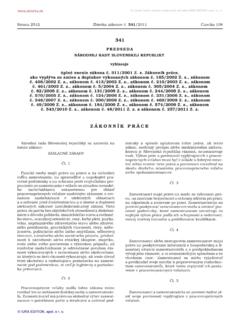Transcription of 1 KID OMD6 - KIDDE Polska
1 GRAVINERMk6 Oil Mist Detection SystemCrankcase explosions due to ignition of oil mist can be disastrous to bothvessel and crew, so marine safety equipment on board must be capable ofdealing with a possible hazard in seconds. Since the potential hazard was firstidentified some 50 years ago, the Graviner oil mist detector has been used tomonitor oil mist levels on many thousands of merchant ships and has beensupplied to almost every ship-owning Multi-engine capability High scan rate 64 detectors in seconds Complete flexibility up to 8 engines on a single system Pipe-free installation Compact detectors mounted on engine with plug/socket connection Control unit located in engine control room or other suitable location, connected to detectors viajunction box Low initial cost and simple to extend Simple cable run between engine and control unit 24v DC operation No air supply or extractor fans needed Event LogEfficiently lubricated machinery is ascritical to the reliability and operatingsafety of modern diesel engines as ithas always been.
2 Rapid advances inlubrication technology and the latestcomputer aided production techniqueshave done much in recent years tosignificantly improve both marine andland-based mechanical failures in thecrankcase are inevitable. A minorproblem with a bearing shell forexample, will cause a hotspot andgenerate large volumes of oil mist. Ifnot detected quickly, major damagemay be caused to the crankshaft and acrankcase explosion may result. Suchoccurrences may lead to time-charterdelay, loss of revenue, salvage claimsor even, in extreme cases, seriousinjuries or fatalities and loss of sensitivity of early oil mistdetectors enabled very advancedwarnings to be given of incipientbearing failures. In two-strokeengines, warnings were given up to GRAVINER25-6 hours before any problemsbecame apparent. As engine designimproved, power outputs and bearingloads increased and tolerances tofailure rapidly decreased.
3 To keep pace with these trends, oilmist detector design improved interms of better sampling and fasterresponse times. The time has nowarrived where no further fundamentalimprovements can be made to existingsystem concepts, so a radical re-appraisal of Oil Mist Detectoroperating principles was required. Thenew Graviner Mk6 OMD is the unprotectedengine no Oil MistDetectorBuild-up of oil mistdue to hotspot beingundetectedThe possible result ignition of oil mist causinga crankcase explosionAmerican Bureau of Shipping (ABS)Bureau Veritas (BV)China Classification Society (CCS)China Corporation Register of Shipping (CCRS)Det Norske Veritas (DNV)Germanischer Lloyd (GL)Korean Register of Shipping (KRS)Lloyd s Register (LR)Nippon Kaiji Kyokai(NKK)Polish Register of Shipping (PRS)Registro Italiano Navale (RINA)Russian Register of Shipping(RRS)The crankcase of any diesel engine will contain oil mist which is formed bycondensation of oil vapour.
4 The generation of oil vapour depends ontemperature. Under normal conditions, generation of mist and its re-combinationinto liquid oil will be in equilibrium and a constant level of oil mist density will an incipient mechanical failure generates a hotspot , generation of oil mistincreases rapidly and far exceeds the re-combination rate. It is this rapid increasein oil mist which must be identified at an early stage, thereby giving warning ofthe incipient mechanical failure and initiating actions that prevent the oil mistdensity rising to an explosive of Failure 2 Stroke EnginePiston Rod SealCross Head SlidesTop End BearingMain BearingBottom End BearingCross Head BearingAreas of Failure 4 Stroke EnginePiston SeizureTop End BearingPiston Blow byMain BearingCamshaftBearingsBottom EndBearingWhat causes the problem?ApprovalsGRAVINER3 System DescriptionThe merging of Graviner and KIDDE in 1989 brought together oil mist detectionexperience and the latest addressable fire alarm technology.
5 This has allowedthe Mk6 oil mist detector to be developed as an analogue addressable oil mistdetection system, capable of monitoring up to 64 detector heads fitted on up to8 engines. This is achieved without any sample pipes and with the minimum ofcables. Each detector head monitors a single crankspace and is a stand-alonedevice. When assigned a unique address and supplied with 24V DC it will gatheroil mist density data and convert it to a digital signal for transmission via thedata cable to the control control unit can be configured to monitor from one to eight addresses are identified and associated with the appropriate levels, average alarm levels and alarm output requirements are all setfrom the control large LCD display will show, on demand, the signal from each detector andindicate the average oil mist level for each engine. In the event of an alarm, thedisplay will immediately show the oil mist signals for the relevant engine.
6 It alsoenables the individual readings of each detector and the average on an engineto be displayed on demand and automatically under alarm the event of a detector fault, that detector can be isolated without affectingthe other detectors on the engine. The system will continue to operate whilethe faulty detector is SystemsOil mist detection requires a means ofobtaining mist samples formeasurement. This has always beenachieved by means of a system ofsample pipes fitted to the side of theengine. Later systems with individualdetector heads still required somepipework. In addition, internal orexternal fans or pneumatic air moverswere required to obtain the samplesfor analysis. Engine builders andowners have for some time called fora more flexible approach: A systemwhich is simple to install, with nopipework and with no controls in theengine room. The new Graviner Mk6 Oil Mist Detection System meets SYSTEM CONFIGURATIONENGINE ROOMCONTROL ROOMAUXILIARY ENGINE5 CYLINDERMK6 CONTROL UNITJ BOXJ BOXMK6 OMDJ BOXMAIN ENGINE7 CYLINDERAUXILIARY ENGINE5 CYLINDERDETECTORSGRAVINER4 Technical DataOil mist detection using well proven sampling method.
7 System is selectable to scan between 1 and 64detectors. Microprocessor electronics ensures very high degree of active fault indication. Each detector can beindividually measured to enable condition monitoring of each : Black Zytel 70G30 Nylon 66 Junction Box: Cast AluminiumControl Unit: Painted mild steel enclosure Response timeLess than seconds for a 64 detector average crankspace oil mist densities between and Easily adjustable by customer to suit individual engine (lower explosion limit 30 - 50mg/l depending upon oil type). Detects variation of individual crankspace densities from the average of between and (simple adjustment by customer).Operating Temperature Detector and Junction Box: 0 - 70 C (ambient and sample temperature)Control Unit: 0 - 55 C temperature-20 C to +60 CSystem ProtectionDetector and Junction Box: Designed to meet IP65.
8 Salt fog Unit: Designed to meet Voltage24V DC (+30% -25%)Power ConsumptionDetector: 116mA Control Unit: 215mAProtectionBy self re-settable fuse inside Control Unit, junction box amp fuseInsulationFlash tested to 2000V for 1 minuteImmunity to noiseSystem tested to requirements of classification societies including:- Radiated susceptibility to radiated noise- Conducted susceptibility to electrical noise- Short duration supply interruption- 1kV high frequency transient OutputsFault alarm: 1 set volt-free change-over relay contacts. Relay normally energised when system is powered. De-energises for fault or test alarm: 1 set volt-free change-over relay contacts. Relay normally energised when system is powered. De-energises for alarm or test slow down: 8 sets of volt-free change-over relay contacts. Relays normally de-energised when system is powered.
9 Energises for alarm or test relay contacts30V 1 Amp DCSystem dimensions Detector: 95 x 90 x 175 Junction Box: 260 x 160 x 90 Control Unit: 500 x 290 x 121 (L x W x H) (mm)System weights (kg)Detector: Junction Box: Unit: KIDDE Fire Protection6257/2 Fire ProtectionThame Park Road, Thame, Oxfordshire OX9 3 RTTel: +44 (0)1844 265003. Fax: +44 (0)1844 265156. E-mail: Web: Fire Protection operates a continuous programme of product development. The right is therefore reserved to modify anyspecification without prior notice and KIDDE Fire Protection should be contacted to ensure that the current issues of all technicaldata sheets are used.









